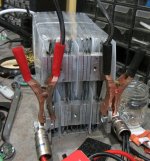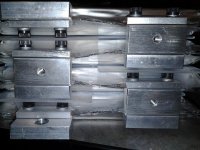I hope it works for you long enough to enjoy your project.

Here are some observations:
If you suspend any unsupported weight on the tabs of a pouch cell in a high vibration environment, the connection internal in the pouch between the aluminum positive tab and the aluminum foil layers will flex as the unsupported mass bounces around, the foils will fatigue, work-harden, and crack away from the tab internally. Anything connected to a tab MUST be mechanically supported if you wish for a long life on something. In the case of a go-kart, it might not get time to fail, and hopefully works out fine.

NEVER conduct through a fastener, and if you're going to for some reason, silicon bronze is the lowest conductivity type of bronze available. It's generally 1/10th or less the conductivity of copper (the stronger alloys often used in fasteners being 1/20th the conductivity). In a go-kart application, you'll be chassis limited to pulling high currents for short periods of time, so it likely won't be an urgent failure point, but it would be wise to check the tension on the nuts, as thermal cycles on relatively slippery bronze fasteners tend to walk the fasteners tension off.
Suspending a cantilevered cable/lug mass unsupported off the tabs is extremely poor practice, in a vibration test I can assure you it would tear the tabs off when the vibe sweep hits the natural freq of that suspended mass. Fortunately, for this go-kart application, it's unlikely to see more than a dozen or two hours of use, so hopefully it doesn't have time to fail.
The clamping area is almost non-existent for tabs on the edges. A 1mm piece of spring steel that is curved to have the concave side facing the tab that needs to be clamped and added to the stack-up would be a good idea for those edges. Similarly, in a future design, using 3 small fasteners, made of good steel (remember, your goal is to never conduct through them, just using them for the clamp load) would be a much better option.
Pouch bodies seem greatly under supported. When these pouches get warm (and they might never get warm if used in a go-kart), they become very soft, almost cooked pasta soft, and require good structural support to keep them from collapsing on themselves.
The box is huge and thick with lots of air space and polycarb is a good insulator. It would not work as an extended high current battery, fortunately, a kart can only use little bursts and cooling is unlikely to be an issue at all. For a kart, low weight is the whole reason they are quick. I think a stack up of cells with some thick aluminum end plates (over sized a bit so the bands dont touch the pouch stacks) tightly snugged band clamps strapping the assembly together would give you a good mechanical retention system that provides good pressure and is low weight. You could slide in 1/16" lexan sheets on the edges of the cells before strapping the steel bands down. Any place that ships equipment on pallets would be able to put some steel band clamps on for you.
Most importantly though, you made a pack! And It's going to get that kart moving and making smiles on your face, which means you're winning, and your future pack designs will be that much better.























































































